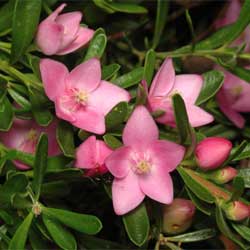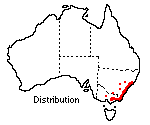Crowea exalata
 |
Crowea or Waxflower
The small Crowea or Waxflower (Crowea exalata) is a native shrub of Victoria, related to the Boronias, and valued for the quality and quantity of its flowers. One of its brightest displays comes when most welcome, during autumn and winter. It is frost hardy and suited to cool and moist rather than hot conditions. Plants have been lost at about five years old following droughts and drying winds, though a well-watered and trimmed plant may be kept for years.
 Of
slight and flexible growth, it spreads outwards more than upwards, to about
1 m across by 70 cm high, and this is a good size at which to keep it. The general
effect is dome-shaped, sometimes arching gracefully but more often twiggy and
irregular. The small narrow leaves are neat and smooth, but uninteresting in
appearance. When bruised they release a bitter scent.
Of
slight and flexible growth, it spreads outwards more than upwards, to about
1 m across by 70 cm high, and this is a good size at which to keep it. The general
effect is dome-shaped, sometimes arching gracefully but more often twiggy and
irregular. The small narrow leaves are neat and smooth, but uninteresting in
appearance. When bruised they release a bitter scent.
This species flowers during most months of the year, resting only in extremes of heat and cold, and with flushes in autumn and spring. Pointed buds open to five-petalled starry flowers 2 cm across, in clear tints of rose purple. They are of a solid waxy substance, and make a vivid display for the size of the plant. Before falling they close again to look like buds of deeper pink. Seed has not been found in Canberra, but propagation by cuttings is easy using tip growth (which is very soft in character), at a half-ripe stage.
Nurseries
dealing in native plants usually stock this small shrub and it should be planted
in light, lime-free soil. A position with some shade is desirable - otherwise
the soil should be shaded in some way from hot sun. This may be done by surrounding
the plant with 5-10 cm of leaves, bush litter or compost. Rocks make an attractive
setting, and in fact this is a beautiful rockery subject. Pruning should be
done to maintain bushy growth, or a straggly plant with bare stems may develop.
The end of winter is a good time to do this - or any time when sprigs of cut
flowers are wanted, as these are dainty and long-lasting in water.
Another beautiful, related species is Crowea saligna, a small shrub less
bushy in habit and weakly upright. It has larger leaves and flowers of the same
vivid pink and it needs similar treatment. It is slightly tender to frost which
brings up high foliage tints, and it may need protecting by hessian in winter. Crowea saligna flowers from autumn to late winter.
Based on text by ANBG staff (1973)
Name meaning: Crowea exalataCrowea - after English surgeon and botanist, James Crowe; exalata - wingless (its relevance is doubtful but possibly concerns the fruit) |
![An Australian Government Initiative [logo]](/images/austgovt_brown_90px.gif)

